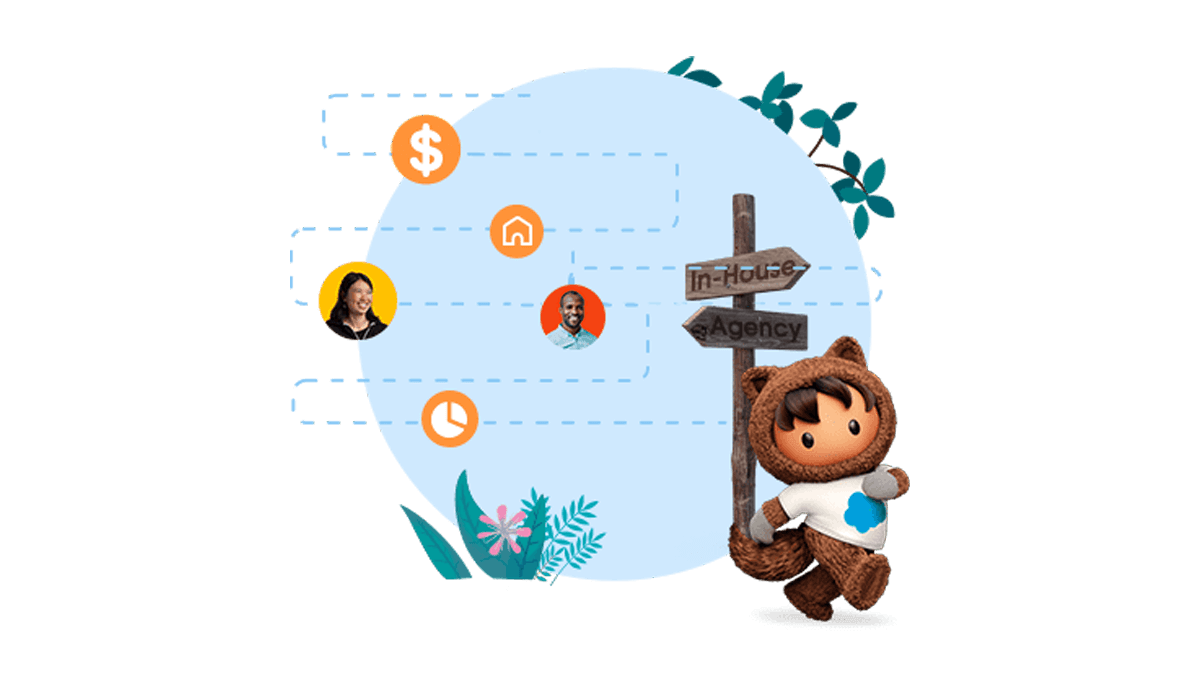
What is Digital Marketing?
1. What Is Digital Marketing?
What does that mean for your business? It means that along with the several thousand people who might see your billboard, you can reach millions of people around the world through digital marketing and lead them through a digital journey.
This guide explains the basics of digital marketing, including its definition, the benefits of doing it, and the main digital marketing channels to use. Each section breaks down what you need to know and includes tips you can use today. There are also links to additional resources that can help your business reach potential customers whether they’re down the street or across the globe.
What Is Digital Marketing?
Digital marketing is any marketing action that occurs on digital platforms, regardless of whether the device is connected to the internet. Under the umbrella of digital marketing is online marketing, which includes email marketing, paid ads on social media platforms, and search engine optimization (SEO).
The terms digital marketing and online marketing are often used interchangeably, but marketers should be aware of the difference. “Digital marketing” describes all marketing strategies that use digital services (like social media or television ads), while “online marketing” describes marketing strategies that are executed via the internet. While the line between them can become blurry, the current understanding of these terms defines online marketing as a type of digital marketing.
Approximately
90%
Why Is Digital Marketing Important for Businesses?
Digital marketing is crucial for business growth in today's technology-driven world. Consumers spend many hours every day online checking email, using social media, reading news, and shopping. In fact, research shows that in 2020, U.S. adults spent an average of seven hours and 50 minutes per day with their digital devices, a 15% increase over 2019. That growth continued into 2021 and is expected to continue in 2022, with no signs of slowing down.
Using digital marketing can expand revenue potential and growth. Unlike old-school tactics like billboards and radio ads, digital marketing helps organizations carefully target their ideal audiences, which results in a higher return on investment (ROI) than traditional, offline marketing methods.
What Are the Benefits of Digital Marketing?
In addition to reaching a targeted audience, there are other benefits of digital marketing, including:
- It’s cost-effective: Small and midsize businesses often struggle to compete with big brands. Digital marketing helps even the playing field. With a clear digital marketing strategy, even a small budget can help drive leads and customers to your website, app, or in-person store.
- It’s easy to measure: Some marketing campaigns generate decent ROI, but it’s hard to attribute a sale to a specific ad or see clear success metrics. Using an integrated digital marketing strategy, you can track users across the entire buying cycle to better understand what works — and what could be improved. In fact, 72% of high-performing marketing teams analyze performance in real time.
- It drives engagement: With digital marketing, brands can interact with customers wherever they are in the customer journey. For example, you can educate, answer questions, even provide customer service all from one platform.
- It’s personalized to customers: Digital marketing allows for segmenting customers based on their interests and engagement history to create personalized experiences at scale. This gives businesses the opportunity to impress customers at every step of their journey.
- It’s possible to update and optimize: Once a direct mailer is in transit or a billboard goes up, you can't make changes. With digital marketing, brands can test different headlines, fix typos, and tweak ads with the click of a few buttons, and changes appear immediately.
72%
of high-performing marketing teams can analyze performance in real time.
2. What Are the Different Types of Digital Marketing?
There are dozens of digital marketing channels you can use to carry out your strategy, including social media sites, SMS, and more. The sheer number of options can be overwhelming.
Below are explanations of four basic types of digital marketing: social media marketing, search engine optimization (SEO), pay per click (PPC), and email marketing. Remember, digital marketing is customizable and easy to change. If a strategy isn’t as successful as you’d like, rethink your plan, change platforms or tactics, and try something new.
Social Media Marketing
Social media marketing leverages platforms such as Facebook, Twitter, LinkedIn, TikTok, and Instagram to build connections with potential customers and drive leads or sales.
Social media is the second most-popular digital channel for marketers, with 83% of marketers using it for customer and prospect communication.
83%
of marketers
There are two main types of social media marketing, which you’ll recognize from the section above:
- Inbound social media: Posting educational information, sharing resources, using paid ads (such as those promoting a lead gen campaign), even sharing funny memes, all of which helps you build a relationship with your audience.
- Outbound social media: Commenting on other social media profiles or participating in hashtag conversations are modern takes on the classic “interruption” style of outbound marketing that help with brand awareness and brand building.
Nearly every type of business, from a small ecommerce business to large enterprise organizations, can use social media to drive customer engagement, leads, and sales.
These are the main benefits of social media marketing:
- Detailed targeting: Most platforms allow marketing teams to target ideal customer profiles based on demographics, interests, location, and language. This prevents wasting ad spend to reach audiences who aren't interested in your campaign.
- Build brand awareness and trust: Consumers don't generally make a purchase the first time they hear about a brand. With social media, you can reach your audience multiple times as they move through the sales funnel.
- It’s affordable: Social media marketing can be done with little to no budget. While you do have to pay for ads, brands can post and interact with consumers for free through brand accounts.
- Easy-to-monitor results: Social media platforms and third-party tools offer analytics and tracking dashboards so you can monitor results, track interactions, and better understand your audience.
91%
of marketing organizations use social media as one of their marketing channels.
Search Engine Optimization (SEO)
Search engine optimization is a digital marketing strategy to help a website appear in results when users look up a word or phrase. SEO is effective and imperative for all organizations, including small local companies, online-only brands, and enterprises.
Why does SEO matter? When consumers look for a solution to a challenge, whether that challenge is what to eat for dinner or which payment processor to use for their business, they head to a search engine like Google. There, they’ll read reviews, ask technical questions, and perform other searches that tie into where they are in their customer journey.
There are nearly 100,000 Google searches every second. SEO helps your business show up when users search terms related to your business.

There are several types of SEO. These include:
- Local: A subsection of SEO that helps businesses, such as a family-owned restaurant, show up in local search results.
- Technical: Technical optimization of websites to increase search rankings, often performed by a developer or professional SEO developer and can involve changes to the code for the site.
- On-page SEO: Optimization techniques applied to pages on your website that are visible to viewers, such as adding internal links, optimizing blog posts for SEO, or using key terms in meta titles.
- Off-page SEO: Optimization techniques that happen off your website, such as building backlinks, using PR and news announcements, or using social media to drive SEO results.
Pay per Click (PPC)
PPC refers to the use of paid ads to reach a highly targeted audience. For example, you could create an ad campaign that targets your potential customers who visit your favorite news site. You can also use Google Ads to target users who search for a specific term like “buy a new [brand name] laptop.”
Unlike billboard or radio ads, where businesses pay upfront, with PPC you only pay if a user actually clicks on your ads. Some platforms do charge by impression or view, but that is less common.
Considering PPC? Here are four benefits to keep in mind:
- Track your traffic: Using Urchin Tracking Modules (UTM) parameters allows you to see where traffic from your ads go — and how often they convert.
- Make changes quickly: Did you make a mistake or want to test a new marketing approach? With PPC, you can change and relaunch ads in minutes.
- Reach a targeted audience: With paid ad platforms like Google Ads and Bing, you can choose exactly who you want to reach based on your internal email address list, current customers, specific demographics, or onsite behavior.
- Expand your reach: If you’re launching a new product or want to expand to a new market, PPC can help your business reach a wider audience.
Whether you want to launch a new brand or bring back past customers, PPC can help you reach your marketing goals. Learn more about Google Ads, Google‘s PPC platform, here.
Email Marketing
82%
of marketers used email for customer and prospect communication in 2020.
More benefits to email marketing include:
- Complete control: Unlike SEO or social media, where other companies (Google, Bing, Facebook, Twitter) control your connection and reach, email marketing lets you connect directly with consumers. You do have to optimize to ensure your email metrics stay healthy, and there are email marketing best practices to follow just for that reason.
- Audience segmentation and personalization: Email marketing software makes sending different emails to different audiences or personalizing marketing strategies to each subscriber possible.
- High ROI: Email marketing has an average ROI of 3,800%, making it one of the most cost-effective marketing strategies.
Additionally, email marketing can be used at each stage of the marketing funnel, and continuing after the purchase. For example, you can drive traffic to your blog, launch a new product, promote your Black Friday sale, remind users to complete a purchase after abandoning their cart, and ask for reviews post-sale.
The first steps in email marketing are building an email list and finding the right email marketing platform. Then, follow these email marketing tips to build a successful email marketing campaign.
3. How to Create a Digital Marketing Strategy
Here's a seven-step guide to help you create an effective digital marketing strategy for your business.
- Outline your goals: What do you want to accomplish? For example, do you want to increase traffic to your website, get more leads, increase sales by 20%, or launch a new product next quarter? Use the SMART framework and V2MOM to create actionable goals.
- Define your target audience: Who do you want to reach? How old are they, where do they live, and what are their interests? B2B companies should consider their target account’s company size, industry, and income.
- Choose the right digital marketing channel: Use your goals and target audience to decide on the most effective channel. For example, a B2B company that wants to reach chief marketing officers will have more success on LinkedIn than TikTok. However, email marketing can be effective for most marketing goals and businesses and should be part of an integrated marketing campaign.
- Set key performance indicators or KPIs: How do you determine if a campaign meets your goals? KPIs help marketers turn data into actionable insights. For example, if your goal is to drive traffic to a blog through an email campaign, you could use traffic acquisition on your blog or email click-through rates to see how effective your strategies and campaigns are.
- Create a launch plan: Determine what you need to implement your campaign, who needs to be involved, and what everyone needs to do. Consider the resources, such as writers and designers, needed to launch your campaign. Create a launch calendar to keep everyone on track.
- Track metrics: Are your ads driving sales? Are you ranking for targeted keywords and terms? Tracking metrics will provide answers to these questions.
- Optimize your strategy: Track metrics for a few weeks. Is the campaign reaching your goals? If not, adjust your strategy. Test new ad copy, headlines, subject lines, optimize blog post titles and landing pages, or test new keywords.
How to Budget for Digital Marketing
Digital marketing is effective, and a portion of your overall marketing budget should be set aside for it. Your industry, target audience, and strategy will impact your budget decisions.
Small businesses can follow these four steps to hone in on a baseline digital marketing budget.
- Align your budget with your strategy: Make sure the money you spend goes toward reaching your target audience. Spreading your marketing budget thinly over a range of demographics won’t move the needle if your marketing strategy is focused on reaching a specific target audience.
- Audit your current spend: Look at what you already spend on marketing each month, quarter, and year, and divide that budget among your current marketing initiatives.
- Measure and evaluate: It’s hard to determine success if you’re not keeping score. Track your marketing ROI by tracking key analytics across each channel. Use the KPIs you created as part of your marketing strategy, and set up some dashboards to make it easy.
- Tighten up your spending: Take a look at all current marketing efforts and hit the brakes on any that are stagnant, or even generating negative ROI. Cut costs by negotiating with vendors and eliminating unnecessary budget items.

Follow these steps and you’ll wind up with a lean, baseline budget, and a streamlined view of your core marketing strategy. Look at the channels that perform well for you, and generate new campaigns and priorities based on the data.
There’s a lot more where that came from — this resource walks through the different factors impacting marketing budgets, and how to find the right allotment for your company’s needs.
Building a Digital Marketing Team
Having a digital marketing team is an important piece to success. The good news is that you can customize your digital marketing team to fit your specific needs, budget, and goals.
First, decide whether an in-house team or an external agency best fits your needs. An in-house team may understand your business better and implement changes faster, as no project onboarding is required. Agencies often have more resources and a higher skill set, which can deliver results faster.
Here are three steps to building your digital marketing team.
- Identify the overall goals and strategy that you want to implement. It’s hard to find the right team if you don't know if you need a content marketer first or an SEO manager.
- Choose a team based on their skill set and relevant experience. If you’re building an in-house team, also consider their personal interests and ability to learn. Digital marketing changes fast, so a willingness to learn and stay updated on current tactics is crucial.
- Create a plan for long-term success. Check in with the team regularly to see if they need additional resources, training, or tools.
4. Future of Digital Marketing
Digital marketing is constantly changing. Google updates its algorithms. New social media platforms gain market share. Even consumer preferences can impact the most effective strategies.
Here are a few digital marketing trends to keep an eye on.
81%
of marketing organizations
Digital Marketing Automation
Digital marketing automation uses tools to automate repetitive marketing tasks. In fact, marketing automation and journey management tools are used by 81% of marketing organizations.
This gives digital marketers and business leaders more time to focus on tasks that require a human touch. Here are a few ways automation can help drive digital marketing success.
- Social media automation: Schedule posts in advance, use templates to respond to common customer questions, or automatically post articles your audience might find interesting.
- Create digital marketing reports: Create templates and connect different platforms to automatically generate marketing reports. You'll have more time to analyze results when you don‘t have to spend additional time pulling data.
- Email marketing automation: Create drip campaigns to automatically deliver targeted messages at just the right time. Automation can also help segment audiences, send cart recovery emails, and engage users through email marketing messages.
- Ad targeting and bidding: Platforms like Google Ads use automation and AI to automatically adjust ad bidding and targeting. This is ideal for teams with limited PPC experience.
- Sales and CRM automation: Automatically send personalized messages, notify sales teams of new leads, create new lead accounts, and much more with sales and CRM automation.
Artificial Intelligence (AI)
AI refers to software or algorithms that can “learn” by applying lessons learned in one situation to another. According to McKinsey & Company, half of all organizations have adopted AI to help with at least one business function.
In digital marketing, AI can help perform intelligent processes, such as forecasting results, planning new strategies, capturing and inputting data, analyzing data, and much more.
There are several benefits to AI, including:
- Improving scalability by automating tasks that previously required a human to manually perform those tasks.
- Reducing digital marketing costs by allowing machines to take over less critical marketing tasks.
- Providing more detailed insights and collecting more data so teams can better visualize the impact of digital marketing campaigns.
Learn more about how to use AI to drive digital marketing success here.
50%
of companies
Digital Marketing with Web3, NFTs, and the Metaverse
Web3 and the metaverse are two names being used to describe the next generation of internet experiences starting to make their way into the public eye. The terms serve as umbrellas for a host of technologies you may be hearing about, including blockchain, cryptocurrency, NFTs, and virtual and augmented reality (VR/AR).
The technical details underpinning these new technologies are complex and rapidly evolving. As a digital marketer, you don’t need to get into the weeds on exactly how it all works. If you’re interested, there are plenty of great explanations out there that get into the history, technical advances, and futuristic visions shaping the internet.
That said, here’s an overview of three emerging technologies that digital marketers should be aware of.
The metaverse is a vision for an internet comprised of immersive virtual worlds much like those depicted in Snow Crash, Ready Player One, and other works of science fiction. These worlds promise rich media experiences, digital real estate, and economic systems that bridge the online and offline worlds. A fun way to think of it is as the internet reimagined by gamers. Though we’re still a ways away from a fully realized metaverse that blends the real and digital worlds, games like Fortnite, Minecraft, and Roblox and newer platforms like Meta Horizons, Decentraland, and The Sandbox offer a taste of what’s to come.

Innovative brands and marketers are already finding success building experiences and hosting virtual events on some of these platforms. A few uses cases of note:
The video game Fortnite drew 12.3 million concurrent viewers to an in-game Travis Scott concert in April 2020. That broke the previous record for most viewers of a live Fortnite event — the 10.7 million who logged in to see Marshmello perform in 2019.
Nike built a virtual experience called Nikeland inside the Roblox gaming platform. Inspired by the company’s real-life headquarters, Nikeland features mini-games, a digital showroom full of virtual sneakers and goods for player avatars, and a toolkit users can leverage to create their own sports-themed games. The collaboration then went a step further with a Nikeland-inspired “digital activation” inside of Nike’s New York City flagship store.
Innovative brands already use NFTs as a way to reward loyal customers and build community. A few use cases that might spark your own marketing genius:
- The unique nature of NFTs is well suited to ticket sales. A one-of-a-kind digital token built atop a transparent and verifiable technology — with an integrated payment system, to boot — could have big potential for primary and secondary ticket markets. The technology also lends itself well to other aspects of the ticketing industry, including fraud prevention, and rethinking how performers and sports teams can share in revenue from ticket resales. NFL and NBA teams are also experimenting with reinventing the sports memorabilia industry by attaching collectible NFTs to traditional tickets.
- NFTs can be used to unlock customer access to exclusive online content and goods, and grant membership into brand-related communities and experiences. An early example is sports brand adidas’ first foray into the space. adidas created a limited number of NFTs that granted holders digital items to wear in the metaverse, exclusive access to purchase physical products, and entry to special physical and virtual experiences.
- Luxury brands have gravitated to NFTs as a way to verify authenticity in a world full of knockoffs. Whisky maker Glenfiddich launched a series of 15 limited-edition NFTs, each of which corresponds to a physical bottle of a 46-year-old single malt whisky. The NFTs serve as proof of authenticity and ownership of the rare spirit, and can be bought and sold on digital platforms or cashed in at any time for the whisky itself.
5. Conclusion
Digital marketing can help grow your business, open up new revenue channels, find leads, and drive sales. However, there is no one-size-fits-all strategy that works for every brand.
Start small. Choose one platform or channel where your audience spends a great deal of time. Create helpful content for your target audience. And remember, digital marketing helps make sales, but it’s all about building relationships with your customers.
More Resources

Guide
The Transformation Playbook

Research
Small and Medium Business Trends Report

Article
Ultimate Guide to Small Business Marketing

